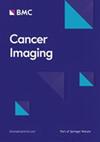Prediction of axillary lymph node metastasis using a magnetic resonance imaging radiomics model of invasive breast cancer primary tumor
IF 3.5
2区 医学
Q2 ONCOLOGY
引用次数: 0
Abstract
This study investigated the clinical value of breast magnetic resonance imaging (MRI) radiomics for predicting axillary lymph node metastasis (ALNM) and to compare the discriminative abilities of different combinations of MRI sequences. This study included 141 patients diagnosed with invasive breast cancer from two centers (center 1: n = 101, center 2: n = 40). Patients from center 1 were randomly divided into training set and test set 1. Patients from center 2 were assigned to the test set 2. All participants underwent preoperative MRI, and four distinct MRI sequences were obtained. The volume of interest (VOI) of the breast tumor was delineated on the dynamic contrast-enhanced (DCE) postcontrast phase 2 sequence, and the VOIs of other sequences were adjusted when required. Subsequently, radiomics features were extracted from the VOIs using an open-source package. Both single- and multisequence radiomics models were constructed using the logistic regression method in the training set. The area under the receiver operating characteristic curve (AUC), accuracy, sensitivity, specificity, and precision of the radiomics model for the test set 1 and test set 2 were calculated. Finally, the diagnostic performance of each model was compared with the diagnostic level of junior and senior radiologists. The single-sequence ALNM classifier derived from DCE postcontrast phase 1 had the best performance for both test set 1 (AUC = 0.891) and test set 2 (AUC = 0.619). The best-performing multisequence ALNM classifiers for both test set 1 (AUC = 0.910) and test set 2 (AUC = 0.717) were generated from DCE postcontrast phase 1, T2-weighted imaging, and diffusion-weighted imaging single-sequence ALNM classifiers. Both had a higher diagnostic level than the junior and senior radiologists. The combination of DCE postcontrast phase 1, T2-weighted imaging, and diffusion-weighted imaging radiomics features had the best performance in predicting ALNM from breast cancer. Our study presents a well-performing and noninvasive tool for ALNM prediction in patients with breast cancer.利用侵袭性乳腺癌原发肿瘤的磁共振成像放射组学模型预测腋窝淋巴结转移
本研究探讨了乳腺磁共振成像(MRI)放射组学在预测腋窝淋巴结转移(ALNM)方面的临床价值,并比较了不同磁共振成像序列组合的判别能力。这项研究包括来自两个中心(中心1:n = 101,中心2:n = 40)的141名确诊为浸润性乳腺癌的患者。中心 1 的患者被随机分为训练集和测试集 1。中心 2 的患者被分配到测试集 2。所有参与者都接受了术前核磁共振成像检查,并获得了四个不同的核磁共振成像序列。乳腺肿瘤的感兴趣容积(VOI)在动态对比增强(DCE)后对比第二阶段序列上划定,其他序列的感兴趣容积在需要时进行调整。随后,使用一个开源软件包从 VOIs 中提取放射组学特征。在训练集中使用逻辑回归法构建了单序列和多序列放射组学模型。计算了辐射组学模型在测试集 1 和测试集 2 中的接收者操作特征曲线下面积(AUC)、准确性、灵敏度、特异性和精确度。最后,将每个模型的诊断性能与初级和高级放射科医生的诊断水平进行了比较。在测试集 1(AUC = 0.891)和测试集 2(AUC = 0.619)中,从 DCE 后对比阶段 1 得出的单序列 ALNM 分类器表现最佳。在测试集 1(AUC = 0.910)和测试集 2(AUC = 0.717)中表现最佳的多序列 ALNM 分类器是由 DCE 对比后一期、T2 加权成像和扩散加权成像单序列 ALNM 分类器生成的。两者的诊断水平均高于初级和高级放射科医生。DCE对比后一期、T2加权成像和弥散加权成像放射组学特征组合在预测乳腺癌ALNM方面表现最佳。我们的研究为乳腺癌患者的 ALNM 预测提供了一种性能良好的无创工具。
本文章由计算机程序翻译,如有差异,请以英文原文为准。
求助全文
约1分钟内获得全文
求助全文
来源期刊

Cancer Imaging
ONCOLOGY-RADIOLOGY, NUCLEAR MEDICINE & MEDICAL IMAGING
CiteScore
7.00
自引率
0.00%
发文量
66
审稿时长
>12 weeks
期刊介绍:
Cancer Imaging is an open access, peer-reviewed journal publishing original articles, reviews and editorials written by expert international radiologists working in oncology.
The journal encompasses CT, MR, PET, ultrasound, radionuclide and multimodal imaging in all kinds of malignant tumours, plus new developments, techniques and innovations. Topics of interest include:
Breast Imaging
Chest
Complications of treatment
Ear, Nose & Throat
Gastrointestinal
Hepatobiliary & Pancreatic
Imaging biomarkers
Interventional
Lymphoma
Measurement of tumour response
Molecular functional imaging
Musculoskeletal
Neuro oncology
Nuclear Medicine
Paediatric.
 求助内容:
求助内容: 应助结果提醒方式:
应助结果提醒方式:


